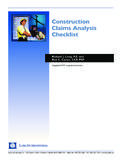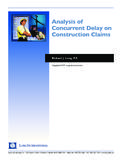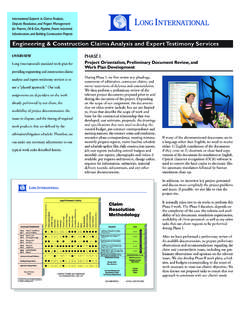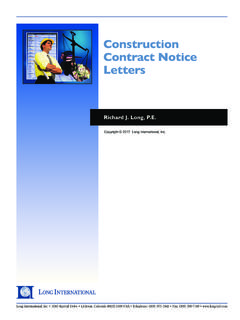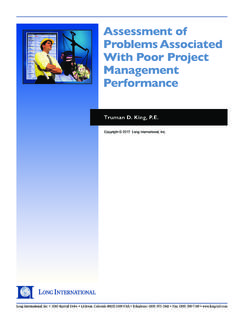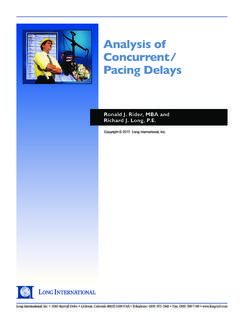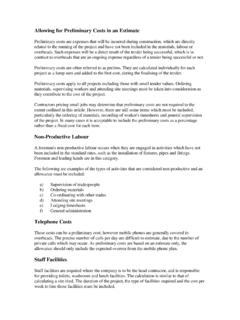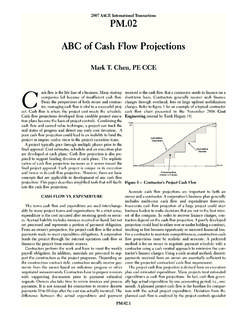Transcription of Richard J. Long, P.E. - Construction Claims Consultants
1 LONG Skytrail DriveLittleton, Colorado 80123 -1566 USAT elephone: (303) 972 - 2443 Fax: (303) 200 -7180 Long International, Inc. Richard J. Long, Claims for Variation in Quantity Richard J. Long, Table of Contents 1. INTRODUCTION .. 1 2. VARIATION IN QUANTITY CLAUSES .. 3 3. LEGAL UNDERPINNINGS .. 8 VICTORY Construction CO. V. UNITED STATES .. 8 BEAN DREDGING CORP .. 9 BURNETT Construction CO. V. UNITED 10 FOLEY CO. V. UNITED STATES .. 11 QUANTITY VARIATION CLAUSES MAY NOT APPLY IN CASES WHERE AN INCORRECT BID WAS CAUSED BY THE GOVERNMENT OR OWNER .. 12 QUANTITIES MAY ALSO APPLY TO HOURS .. 13 4. DIFFERING SITE CONDITIONS CLAUSE AS A REMEDY.
2 14 5. CHANGES CLAUSE AS A REMEDY .. 18 6. NOTICE REQUIREMENTS .. 19 7. GUIDELINES .. 20 Copyright 2017 Long International, Claims for Variation in Quantity 1. INTRODUCTION A component of a Construction claim often relates to the cost , quantity, and quality of the materials that the contractor installed on a project. The contractor frequently purchases these materials and agrees to install the quantities of materials on a unit price basis, , a unit price that includes both the cost of the materials and the cost to install them. The parties may contemplate some minor variations in such quantities from the contract estimate, especially if the engineering documents are not issued Approved for Construction (AFC).
3 Even when AFC drawings are issued prior to establishing the contract price, changes may occur which may cause deviations from the approved design which could significantly increase or decrease the required quantities to be installed and the contractor s costs. Unit price contracts are often used to shorten the overall duration of a project because a detailed design from which final quantity takeoffs can be performed is not necessary to enable a contractor and owner to agree on a contract to perform the Construction work. Thus, field Construction work can start earlier than would otherwise be required in a traditional engineering, procurement, Construction (EPC) contract or design-build contract, where a more precise measure of quantities is necessary to obtain a lump-sum or fixed-price bid from a contractor.
4 Under a unit price contract, a contractor typically buys material, adds a mark-up for overhead and profit, and agrees to perform the work for this unit price. Of prime importance to the contractor is whether its unit prices are sufficient to cover its overhead and other costs if the number of units significantly changes from the estimated quantities used to prepare its bid. If the owner s estimated quantities are higher than the quantities that are actually required, the contractor may have a claim for unrecovered overhead costs and profit. An owner, often in an effort to realize cost savings as a result of value engineering, may change the design, reduce the quantities specification, and request a credit from the contractor.
5 However, the contractor might not pass on the full savings it achieved from the owner s change, potentially causing a dispute with the owner who is expecting a larger credit. Contractors also take risks with unit price contracts. The contractor may tactically apply its overhead and profit percentages in an unbalanced manner to items for which it expects large quantity increases as the design matures, thus receiving an additional layer of profit. As stated by one court: Such a bid, it is explained, is one in which the contractor allocates a disproportionate share of indirect costs and anticipated profit to the unit prices bid for those items on which he anticipates an overrun; the object being to reap over generous profits should the anticipated overruns 1 Victory Construction Co.
6 V. United States, 510 1387 (Ct. Cl. 1975). Copyright 2017 Long International, Claims for Variation in Quantity Such practices could backfire if the quantities of over-priced items do not materially increase or, even worse, decrease as a result of value engineering, thus reducing the contractor s recovery of overhead and profit. Copyright 2017 Long International, Claims for Variation in Quantity 2. VARIATION IN QUANTITY CLAUSES The purpose of Variation in Quantity or similar clauses is to equitably assign the risk of increases or decreases in estimated quantities that result from information or conditions not reasonably apparent to the parties when they enter into the contract.
7 Thus, large quantity variations may require some adjustment to unit prices in contracts to prevent large windfalls or harmful losses. A Changes, Variation in Quantities, or Variation in Estimated Quantity clause is used by the Government and similar clauses are used by owners on private projects to avoid disputes when the actual quantity varies from the estimated quantity because of imprecise estimates. For example, the AIA 201 General Conditions of the Contract for Construction (2007), under Construction Change Directives, states: If unit prices are stated in the Contract Documents or subsequently agreed upon, and if quantities originally contemplated are so changed in a proposed Change Order or Construction Change Directive that application of such unit prices to quantities of Work proposed will cause substantial inequity to the Owner or Contractor, the applicable unit prices shall be equitably adjusted.
8 Government Federal Acquisition Regulations (FAR) contain the following provisions: Supply contracts. (a) A fixed-price supply contract may authorize Government acceptance of a variation in the quantity of items called for if the variation is caused by conditions of loading, shipping, or packing, or by allowances in manufacturing processes. Any permissible variation shall be stated as a percentage and it may be an increase, a decrease, or a combination of both; however, contracts for subsistence items may use other applicable terms of variation in quantity.
9 (b) There should be no standard or usual variation percentage. The overrun or underrun permitted in each contract should be based upon the normal commercial practices of a particular industry for a particular item, and the permitted percentage should be no larger than is necessary to afford a contractor reasonable protection. The permissible variation shall not exceed plus or minus 10 percent unless a different limitation is established in agency regulations. Consideration shall be given to the quantity to which the percentage variation applies. For example, when delivery will be made to multiple destinations and it is desired that the quantity Copyright 2017 Long International, Claims for Variation in Quantity variation apply to the item quantity for each destination, this requirement must be stated in the contract.
10 (c) Contractors are responsible for delivery of the specified quantity of items in a fixed-price contract, within allowable variations , if any. If a contractor delivers a quantity of items in excess of the contract requirements plus any allowable variation in quantity, particularly small dollar value overshipments, it results in unnecessary administrative costs to the Government in determining disposition of the excess quantity. Accordingly, the contract may include the clause at , Delivery of Excess Quantities, to provide that (1) Excess quantities of items totaling up to $250 in value may be retained without compensating the contractor; and (2) Excess quantities of items totaling over $250 in value may, at the Government s option, be either returned at the contractor s expense or retained and paid for at the contract unit price.
